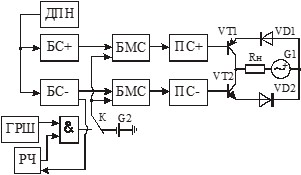Automatic Asynchronous Drive Efficiency Control with Soft-Starter Function Frequency-Step Method of Increasing the Energy Efficiency of Asynchronous Electric Drive Mechanisms of Long-Term Operation. Ideology, Circuit Solution and Testing of Integrated Control Model.
Main Article Content
Abstract
Digital models of pulse-width voltage control system with step switching of power supply frequency and automatic control of induction motor are developed and built, the recommendations on the algorithm of their control and circuit solution for the implementation of smooth start modes, nominal and frequency-step control from low-power -variable load schedule are provided.
The novelty of the work lies in the substantiated sequence and conditions of control and originality of the structure of the automatic system of smooth start-up and activation of the effective mode of the asynchronous drive.
The introduction of the conversion system will create an automatic system of asynchronous drive, due to which it is possible to achieve energy conservation at all levels of the electromechanical system, with minimum capital investment.
Article Details

This work is licensed under a Creative Commons Attribution 4.0 International License.
Authors who publish with this journal agree to the following terms:- Authors retain copyright and grant the journal right of first publication with the work simultaneously licensed under a Creative Commons Attribution License that allows others to share the work with an acknowledgement of the work's authorship and initial publication in this journal.
- Authors are able to enter into separate, additional contractual arrangements for the non-exclusive distribution of the journal's published version of the work (e.g., post it to an institutional repository or publish it in a book), with an acknowledgement of its initial publication in this journal.
- Authors are permitted and encouraged to post their work online (e.g., in institutional repositories or on their website) prior to and during the submission process, as it can lead to productive exchanges, as well as earlier and greater citation of published work (See The Effect of Open Access).
References
B. S. Leznov,. Chastotno-reguliruemyj jelektroprivod nasosnyh ustanovok [Variable Frequency Electric Pumping Units]. Moscow: Mashynostrojenije, 2013.
B. S. Leznov, Energosberezhenie i reguliruemyj privod v nasosnyh i vozdushnyh ustanovkah [Energy saving and controlled drive in pump and air units]. Moscow: Energoatomizdat, 2006.
O. S. Beshta, G. G. Pivnyak, Eds., Ekonomichni j ekologichni aspekty kompleksnoi' generacii' ta utylizacii' energii' v umovah urbanizovanyh terytorij. Monografija [Economic and environmental aspects of integrated generation and utilization of energy in urbanized areas. Monograph]. Dnipropetrovsk, NMU, 2013.
A. E. Kozjaruk, B. Ju. Vasil'ev, “Metody i sredstva povyshenija jenergojeffektivnosti mashin i tehnologij s asinhronnimi elektroprivodami. [Methods and means of increasing the energy efficiency of machines and technologies with asynchronous electric drives],” Bulletin of SUSU. Series "Energy", vol 15, no 1, pp. 47–53. 2015. DOI: https://doi.org/10.14529/power150106.
V. Ja. Bespalov “Novaja vysokojeffektivnaja serija asinhronnyh dvigatelej 7AVE, ee modifikacii i specializirovannye ispolnenija [New high-performance series of 7AVE asynchronous motors, its modifications and specialized versions],” In Trudy VIII Mezhunar. (HІH Vseros.) nauch.-tehn. konf. po avtomatizir. elektroprivodu. 2014, pp. 239-243.
R. G. Mugalimov, A. R. Mugalimova. “Modelirovanie pokazatelej jenergojeffektivnosti variantov jelektroprivodov promyshlennyh ustanovok na osnove primenenija tradicionnyh i kompensirovannyh asinhronnyh dvigatelej [Modeling of energy efficiency indicators of electric drive options of industrial plants based on the use of traditional and compensated asynchronous motors],” Bulletin of MSTU. G. I. Nosova, vol 2 (34), pp. 59-64, 2011. URL: http://vestnik.magtu.ru/content/%D0%92%D0%B5%D1%81%D1%82%D0%BD%D0%B8%D0%BA%20%D0%9C%D0%93%D0%A2%D0%A3%20%D0%B7%D0%B0%202011%20%D0%B3%D0%BE%D0%B4,%20%D0%9D%D0%BE%D0%BC%D0%B5%D1%80%202.pdf
O. A. Kapitonov, A.S. Tret'jakov, G.S. Lenevskij, “Ustrojstvo plavnogo puska s impul'snym regulirovaniem naprjazhenija i kompensaciej reaktivnoj moshhnosti [Soft starter with pulse voltage regulation and ompensated reactive power]”. Vestnik Belorussko-Rossijskogo Universiteta, vol 4(61), pp. 39-48, 2018.
O. N. Parfenovich, O. A. Kapitonov, “Tranzistornyj shirotno-impul'snyj reguljator naprjazhenija dlja asinhronnyh jelektrodvigatelej [Transistor pulse-width voltage regulator for asynchronous electric motors],”. Vestnik Belorussko-Rossijskogo Universiteta, vol 3(28), pp.119-127, 2010. URL: http://cdn.bru.by/cache/science/bulletin/2018/vestnik_2018_4_1.pdf
A. I. Braslavsky, Z. Sh. Ishmatov, V. N. Polyakov Energosberegajushhij asinhronnyj jelektroprivod [Energy saving asynchronous electric drive]. Moscow: Academy, 2004.
B. Vasilev, “Structure and three-level inverter control algorithm electric power facilities transportation of hydrocarbons”. Electrotechnic and computer systems, vol 15(91), pp. 220-223, 2014.
N. N. Kazachkovsky, “Sopostavlenie zakonov chastotnogo upravlenija na primere preobrazovatelja chastoty Altivar 21 [Comparison of the laws of frequency control. Case study of the frequency converter Altivar 21]”. Girnicha elektromehanіka ta avtomatyka, vol 100, pp. 69-72, 2018. URL: https://gea.nmu.org.ua/ua/ntz/archive/100.pdf
A. S. Ushkov, A. R. Kolganov, “Analiz jenergojeffektivnosti asinhronnogo jelektroprivoda s korrektorom kojefficienta moshhnosti [Energy efficiency analysis of an asynchronous electric drive with a power factor corrector],” Vestnik IGJeU, vol 6, pp.1-5, 2013. URL: http://vestnik.ispu.ru/sites/vestnik.ispu.ru/files/publications/str.74-79.pdf
A. S. Ushkov, A. R. Kolganov, “Issledovanie sovremennyh metodov jenergosberegajushhego upravlenija asinhronnym jelektroprivodom [Research of modern methods of energy-saving control of asynchronous electric drive]”. Vestnik IGJeU, vol 2, pp. 56-62, 2012. URL: http://vestnik.ispu.ru/sites/vestnik.ispu.ru/files/publications/56-62.pdf
V. Yu Belousov, Ye. V. Nedorezova, “Jenergosberezhenie i primenenie chastotnyh preobrazovatelej i ustrojstv plavnogo puska [Energy saving and application of frequency converters and soft start devices]”. Izvestija TulGU. Tehnicheskie nauki, vol 6, no. 1, pp. 148-151, 2011.
V. A. Borodaj, “Parametrychne keruvannja efektyvnistju asynhronnogo pryvodu zasobamy peretvorjuvacha z pidvyshhenym koeficijentom potuzhnosti [Parametric control of asynchronous drive efficiency by means of the converter with the increased power factor],” Elektrotehnika ta elektroenergetyka, vol 2, pp. 8-16, 2020. DOI: https://doi.org/10.15588/1607-6761-2020-2-1.





